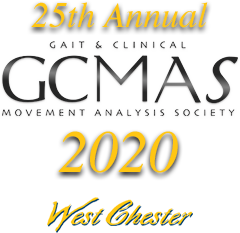- Gait Analysis
- Foot and Ankle
- Trunk and Upper Extremity
- Normal Motion
- Pathological Motion
- Balance/Stability/Posture
- Sports and Sports Performance
- Prosthetics/Orthotics/Assistive Devices
- Muscles/FES/EMG
- Orthopaedics
- Rehabilitation
- Quality Service Delivery and Standards
- Novel Biomechanics
- Data and Analysis Methods
- Tutorials

June 1-5, 2020
Call for Abstracts and Tutorials
Example Abstracts
Please click the links below for example abstract templates
New Tools and Techniques Template
Scientific Study Template
Case Study Template
The GCMAS is pleased to accept abstracts in the areas of:
Abstract submission will begin on November 11th, 2019 and end on January 29th, 2020 through the OpenConf Peer Review Conference Management System. Click here to submit an abstract or tutorial.
If you wish to be a reviewer, please contact the conference chair, Tim Niiler, at tim.niiler@gmail.com.
If you wish to be a reviewer, please contact the conference chair, Tim Niiler, at tim.niiler@gmail.com.
Guidelines for ALL Abstract Submissions
Abstracts are limited to two (2) pages and must be formatted as follows: The content of each page must be contained within a 160 mm X 225 mm (6.3" x 8.8") area. Text should be formatted as Times New Roman 12-pt font.
Abstract reviews will not be blinded. Please submit only ONE abstract, a publication copy. The publication copy should include the title of the paper, the author(s), affiliation(s) and email address of the corresponding author. The name of the presenting author should be underlined. The presenting author listed on the abstract will be required to complete an online disclosure statement for CME/CEU accreditation. The link to this online disclosure will be sent out after abstract acceptance. See Specific Submission Instructions below for additional information.
Guidelines for Scientific Studies:
Abstracts describing original research should be comprised of the following sections: Introduction, Clinical Significance, Methods, Results, Discussion, References, Acknowledgements, and Disclosure Statement. One or two figures may be used, but please ensure that the figures are legible when reduced to half size.
Guidelines for New Tools and Techniques:
Abstracts describing methodological advances should be comprised of the following sections: Introduction, Clinical Significance, Methods, Demonstration, Summary, References, Acknowledgements, and Disclosure Statement. One or two figures may be used, but please ensure that the figures are legible when reduced to half size. Abstracts should describe novel methods (i.e. devices or algorithms) that enhance our ability to visualize, measure, or analyze the mechanics, tendons, joints, and/or limb segments. Abstracts from vendors are encouraged, but must not contain advertising.
Guidelines for Clinical Case Studies:
Abstracts describing clinical case studies should be comprised of the following sections: Subject History, Clinical Data, Motion Data, Treatment Decisions and Indications, Outcome (if available) Summary, and Disclosure Statement. One or two figures may be used, but please ensure that the figures are legible when reduced to half size. Abstracts should illustrate the value of motion analysis and/or modeling in the evaluation, understanding, and/or treatment of a movement disorder. Priority will be given to studies that include pre- and post-treatment data.
Guidelines for Tutorial and Symposia Submissions:
Proposals should include the following sections: title, instructor(s), purpose, intended audience, prerequisite knowledge, and outline of course content. Please prepare proposals with a 12-pt font and limit length to two pages.
At the time of submission, you will need to provide the name and contact information (including email address) of each speaker. Each speaker will be required to complete an online disclosure statement for CME/CEU accreditation. These disclosures will be coordinated through the Program Council after proposal acceptance.
Learning Objectives:
The submission form will require authors to submit a one-sentence learning objective. The learning objective should be of the form: At the completion of this presentation, attendees will be able to (recognize, measure, explain) …